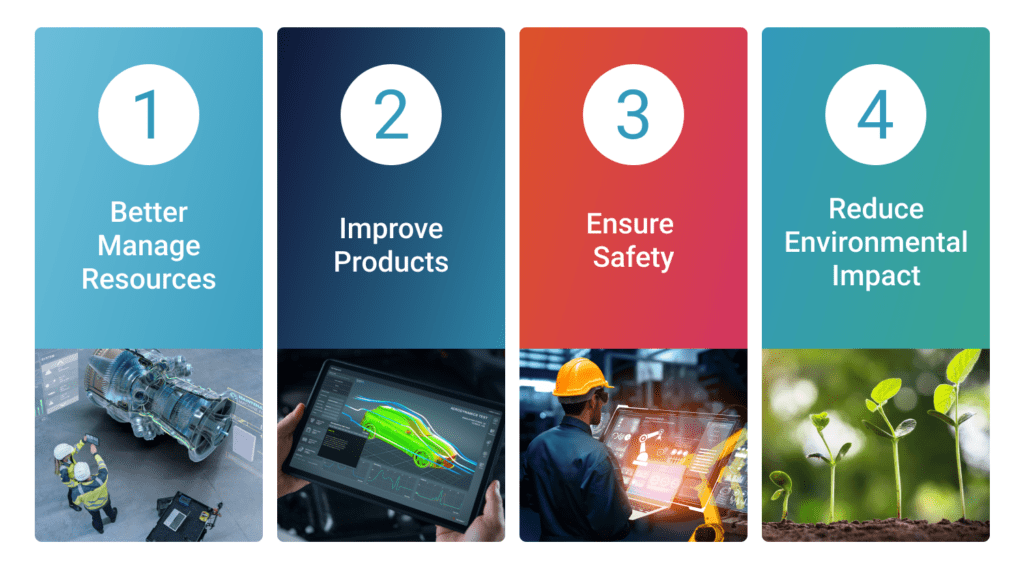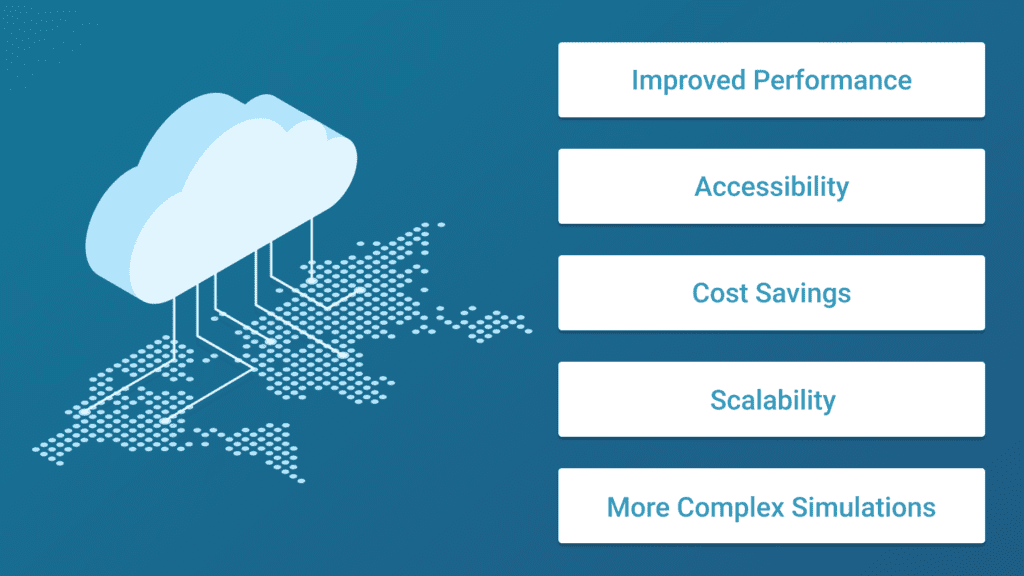CAE Simulation in the Cloud: What It Is, Why It Matters, How It’s Evolved
Computer-aided engineering (CAE) simulations help R&D teams validate their ideas, assess problems, and bring products to market more quickly. Over the past decade, the accessibility of cloud computing resources has made CAE processes more robust.
In this article, we’ll walk through an overview of how CAE simulations work, how they improve bottom-line metrics in enterprise research environments, and how high-performance computing-as-a-service (HPCaaS) is helping evolve the discipline.
What Is a CAE Simulation?
The purpose of a CAE simulation is to examine the performance of a particular design prior to doing any prototyping or physical testing on a new product. The goal is to generate insights for making informed decisions — and to avoid costly mistakes, as a result.
CAE simulations have a wide range of applications across a diverse range of contexts, including drug discovery, materials science, architecture, AI dataset training, weather pattern analysis, and automotive design. Often, engineers building CAE simulations work closely with design teams developing computer-aided design (CAD) models.
CAE simulations date back to the earliest days of computing in the 1950s and 1960s when R&D teams in the aerospace and defense sectors began using computers to simulate the behavior of aircraft structures and engines. These simulations helped engineers design and optimize aircraft more quickly and accurately than was possible with physical testing alone.
In the 1970s and 1980s, the field of CAE simulations began to expand rapidly. As more powerful computers became available, new simulation techniques were developed. In recent years, the availability of cloud hpc resources has decreased the time needed to run simulations from days to hours. As a result, R&D teams are able to run CAE simulations at a higher level of fidelity.
Types of CAE Simulations:
Most CAE simulations begin with a CAD model, which is a virtual (digital) representation of what a product is intended to be. Simulations may be 2D or 3D, depending on fidelity requirements, project complexity, and situational needs.
Specific simulation techniques depend on the real-world scenarios being studied (i.e. vibrational loads, air flow paths, electromagnetics). Examples include:
- Finite Element Analysis (FEA), which simulates the behavior of a structure or component under different loads and boundary conditions using numerical methods. Finite element analysis (FEA) is commonly used in structural analysis, thermal analysis, and fluid dynamics.
- Computational Fluid Dynamics (CFD), which simulates the flow of fluids (e.g., air or water) through a system or component. Computational fluid dynamics (CFD) is used in the design of engines, turbines, and other complex fluid systems.
- Multibody Dynamics, which involves simulating the motion and interactions of multiple rigid bodies under different loads and constraints. MBD is commonly used in automotive and aerospace industries to optimize vehicle dynamics and performance.
- Electromagnetics, which involves simulating the behavior of electromagnetic fields in a system or component. EM is used in the design of antennas, motors, and other electrical systems.
- Manufacturing process simulation, which involves simulating the manufacturing process to optimize production efficiency and reduce costs. This includes simulating processes such as injection molding, casting, and machining.
- Optimization, which involves finding the optimal design parameters for a system or component to meet certain performance requirements. Optimization is commonly used in the design of aircraft wings, turbine blades, and other complex systems.
- Acoustics and vibrations, which involves simulating the behavior of sound and vibrations in a system or component. It is commonly used in the design of vehicles, buildings, and other structures to ensure noise and vibration levels are within acceptable limits.
- Durability and fatigue, which involves simulating the behavior of a component under cyclic loading conditions to predict its lifespan and failure modes. It is commonly used in the design of aerospace, automotive, and other structural components.
- Crash and Impact Analysis, which involves simulating the behavior of a system or component under impact loading conditions to assess its safety and crashworthiness. It is commonly used in the design of vehicles, aircraft, and other safety-critical systems.
- Computational Chemistry, which involves simulating the behavior of molecules and chemical reactions using computational methods. It is commonly used in drug discovery, materials science, and other fields.
- Optics and Photonics, which involves simulating the behavior of light and electromagnetic radiation in optical systems and devices. It is commonly used in the design of lasers, optical fibers, and other photonics systems.
- Human Modeling and Simulation, which involves simulating the behavior of the human body in various environments and conditions. It is commonly used in ergonomic design, medical device design, and other applications.
Why CAE Simulations Matter

CAE simulations are important because they allow engineers and designers to simulate and analyze the performance of a product or system in a virtual environment. This enables R&D teams to:
- Better manage resources. By simulating the behavior of a product or system in a virtual environment, engineers can identify and solve design problems early in the design process, before physical prototypes are built. This saves time and money because physical prototypes can be expensive to produce and test.
- Improve products. CAE simulations help engineers optimize product performance by testing and refining a design in a virtual environment. This can lead to products that are more reliable, efficient, and cost-effective.
- Ensure safety. CAE simulations can be used to simulate and analyze the performance of products in extreme conditions or failure scenarios, allowing engineers to identify potential safety issues and make design improvements before the product is released.
- Reduce environmental impact. By simulating the performance of products in a virtual environment, engineers can optimize designs to reduce environmental impact, such as by minimizing energy consumption or reducing waste.
Overall, CAE simulations are an important tool for engineers and designers, as they allow them to make informed design decisions, optimize product performance, ensure safety, and reduce development costs. When building their CAE optimization strategies and programs, R&D teams will typically balance these practical business constraints with time-to-solve metrics.
The Evolution of Cloud-Based CAE Simulations

The more power that CAE simulations have, the more accurate and reliable these simulations will be, with faster time-to-solve metrics.
The key challenge is that CAE simulations require substantial computing infrastructure to run. While larger enterprises have historically turned to on-premises systems to run workloads, smaller organizations have lacked the budget for this expense. Without enough computing power, simulations are likely to crash.
But cloud-based CAE simulations have leveled the playing field. The introduction of high performance computing as a service (HPCaaS) provides significant benefits to CAE simulations by improving performance, reducing costs, enabling scalability, improving accessibility, and allowing for more complex simulations.
- Improved performance. HPCaaS improves the performance optimization of CAE simulations by providing access to powerful computing resources that perform calculations faster and more efficiently. This can help reduce simulation run times and increase the number of simulations that can be performed in a given time period.
- Cost savings. HPCaaS helps reduce costs associated with CAE simulations. Instead of investing in expensive hardware and software, companies can rent the computing resources they need on-demand. This can help reduce capital expenditures and allow companies to pay only for the resources they use.
- Scalability. HPCaaS provides the ability to scale up or down computing resources based on the needs of the simulation. This can help handle large simulations that require significant computing resources without the need to invest in additional hardware.
- Accessibility. HPCaaS offers access to computing resources from anywhere with an Internet connection, allowing teams to collaborate on simulations remotely.
- More complex simulations. HPCaaS supports the digital simulation of more complex models, such as those with higher resolution, larger dimensions, or more detailed physics. This can lead to better accuracy and more detailed insights into the behavior of a system or a design.
Actualizing Cost-Savings
When evaluating cloud-based solutions for CAE simulations, the decision often comes down to cost. Beyond hardware expenses (i.e. heating, cooling, IT personnel on board, number of cores), software licenses are often very expensive. CAE simulation time tends to be finite, with a precise cost per hour.
By decreasing CAE simulation time, R&D teams can run more experiments — and progress through their queues, faster. As a result, organizations can save on licensing costs.
Efficiencies scale up, and R&D teams become more powerful as a result.
CAE simulations, like much of modern research and engineering, depend on high performance computing HPC to run data-intensive software programs. Digital R&D has opened up all new possibilities for innovation. By ensuring access to high performance computing, cloud hpc is now making these groundbreaking computational research methods much more accessible to a far wider range of organizations.








